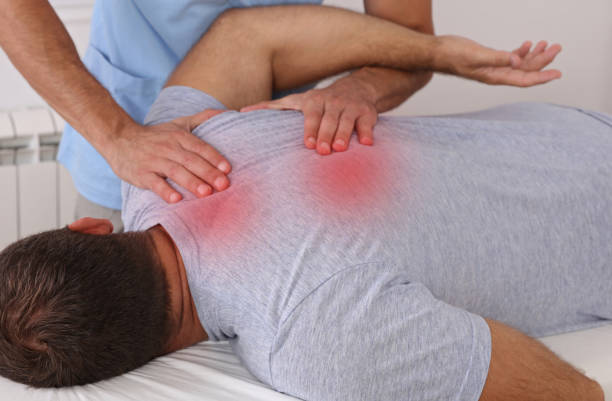Body movement Therapy
Healing Power of Medical Massage Therapy
Medical massage therapy, a specialized type of massage designed to target specific health disorders and relieve symptoms, is gaining popularity as a beneficial supplement to traditional medical therapies. Unlike relaxation massage, which primarily tries to calm the body and mind, medical massage therapy focuses on specific methods to relieve pain, reduce inflammation, and increase range of motion. Medical massage therapy, which has its roots in traditional massage modalities such as Swedish and deep tissue massage, combines evidence-based methods with anatomical understanding to treat musculoskeletal difficulties, neurological illnesses, and chronic pain syndromes. In this article, we will look at the ideas, practices, and therapeutic effects of therapeutic massage, as well as how it can be used in conjunction with other medical procedures to improve overall well-being and speed up healing.

Understanding Medical Massage Therapy
Definition and Objectives
Medical massage therapy is a specialist type of therapeutic massage that is intended to treat certain medical issues as determined by a physician. Its major goal is to provide specialized therapy for a specific medical condition, with an emphasis on health outcomes and recovery. Medical massage therapists are qualified professionals who are educated to identify and address problem areas. They work in a clinical or hospital setting and frequently bill the client’s health insurance.
Medical massage therapy differs from other types of massage treatment, such as relaxation and therapeutic massage. It is more focused on the body’s soft tissue, such as muscles, tendons, and ligaments, which move and support the body. The massage therapist will manipulate the soft tissue with particular methods to treat pain, reduce inflammation, and improve blood circulation.
Medical massage therapy is used to treat a variety of medical disorders, such as chronic pain, sports injuries, carpal tunnel syndrome, sciatica, and fibromyalgia. It can also treat stress-related illnesses like anxiety and depression.
Comparing Therapeutic and Medical Massage
Therapeutic massage is a broad phrase that encompasses all types of massage that are intended to induce relaxation, relieve stress, and improve overall well-being. It is commonly used in spas and wellness centers and is usually not covered by health insurance.
Medical massage therapy, on the other hand, is a type of massage treatment that is specifically developed to address certain medical disorders. It is frequently recommended by a physician and is generally covered by health insurance.
Both therapeutic and medicinal massage therapy can be beneficial, yet they serve distinct functions. Therapeutic massage aims to induce relaxation and alleviate tension, whereas medical massage therapy targets specific medical disorders.
In summary, medical massage therapy is a specialized type of massage therapy that is intended to treat certain medical issues as determined by a physician. Its major goal is to provide specialized therapy for a specific medical condition, with an emphasis on health outcomes and recovery. Medical massage therapists are licensed professionals who practice in clinical or hospital settings, often invoicing the client’s health insurance. It differs from other types of massage therapy, such as relaxation or therapeutic massage, and can be used to treat a variety of medical issues.
Benefits and Effects of Medical Massage
Medical massage therapy has numerous benefits for both physical and mental health. The next sections of this article will go over some of the most important benefits and side effects of medical massage therapy.
Pain Management and Relief
Medical massage treatment can help relieve pain from a wide range of diseases, including chronic pain, injury, and surgery. The massage therapist will utilize a variety of treatments to address the root of the discomfort, including trigger point therapy, myofascial release, and deep tissue massage. These strategies reduce muscle tension, boost blood flow, and promote relaxation, all of which can assist in relieving pain.
Improving Circulation and Reducing Inflammation
Medical massage therapy can also help to enhance circulation and lower inflammation in the body. The massage therapist will utilize methods like effleurage and petrissage to improve blood flow and lymphatic drainage. This can help to reduce swelling and inflammation, which is especially beneficial for people with arthritis or autoimmune illnesses.
Enhancing Range of Motion and Flexibility
Medical massage therapy can also improve the range of motion and flexibility. Stretching and joint mobilization are two techniques used by massage therapists to assist the release of tight muscles and enhance joint mobility. This can be especially useful for athletes or others with conditions that limit their range of motion.
Stress Reduction and Mental Health
Medical massage therapy can also help to relieve stress and improve mental wellness. The massage therapist will utilize techniques like Swedish massage and aromatherapy to help you relax and reduce stress. This is especially helpful for people who suffer from anxiety or despair.
Finally, medical massage treatment provides numerous benefits for both physical and mental health. It can help alleviate pain, improve circulation, increase range of motion and flexibility, and reduce stress and anxiety. Individuals can benefit from therapeutic massage by working with a qualified massage therapist.

Techniques and Modalities of Medical Massage
Medical massage therapy employs a variety of methods and modalities that target specific parts of the body to relieve pain and promote recovery. Here are some of the most commonly utilized techniques in medical massage.
Deep Tissue Massage and Pressure Application
Deep tissue massage targets the muscles and connective tissues at their deepest depths. This technique applies slow, firm pressure and strokes to targeted regions of stress and pain. It can be used to treat chronic pain, injuries, and posture issues.
Pressure application is another method utilized in medical massage. It entails applying pressure to particular places on the body to alleviate discomfort and tension. This technique can be used to alleviate headaches, neck and shoulder discomfort, and other muscle problems.
Myofascial Release and Trigger Point Therapy
Myofascial release is a technique for treating the fascia, the connective tissue that covers muscles and organs. This technique involves applying moderate pressure to the fascia to relieve tension and increase mobility. It can be used to treat chronic pain, injuries, and posture issues.
Trigger point therapy is another method utilized in medical massage. It entails applying pressure to certain trigger points in the muscles to reduce pain and tension. This technique can be used to alleviate headaches, neck and shoulder discomfort, and other muscle problems.
Lymphatic Drainage and Soft Tissue Techniques
Lymphatic drainage is a technique for increasing the flow of lymphatic fluid in the body. This technique uses soft, rhythmic strokes to stimulate the lymphatic system and aid in the elimination of toxins and waste products from the body. It can be used to treat swelling, lymphedema, and other forms of fluid accumulation.
Soft tissue treatments are a range of procedures that target the body’s soft tissues, such as muscles, tendons, and ligaments. These practices can help to increase circulation, relieve pain and tension, and promote healing. Soft tissue techniques include effleurage, petrissage, and friction.
Overall, medical massage therapy provides a variety of techniques and modalities that can be customized to fit the unique needs of each patient. Medical massage, which targets particular parts of the body and employs a variety of methods, can assist to relieve pain, enhance mobility, and promote healing.

Professional Practice and Considerations
Qualifications of a Licensed Massage Therapist
To practice medical massage therapy, a licensed massage therapist must have a solid understanding of anatomy and physiology, as well as the ability to identify and treat a wide range of medical disorders. To maintain their license, qualified massage therapists must complete a comprehensive massage therapy program, pass a state licensure exam, and complete ongoing education requirements.
Integrating Medical Massage into Healthcare
Medical massage treatment is becoming widely used in healthcare settings such as clinics, hospitals, and medical centers. This integration is the result of an increased understanding of massage therapy’s advantages for a wide range of medical issues, including chronic pain, tension, and anxiety.
Medical massage therapists must be able to communicate successfully with other healthcare professionals in order to provide the best care for their patients. They must also be able to work within healthcare settings’ norms and protocols, such as adhering to infection control measures and protecting patient privacy and confidentiality.
Insurance and Accessibility
Many health insurance plans now provide medical massage therapy for specific medical disorders. However, coverage varies by plan and state, so patients should contact their insurance provider to establish their coverage.
Medical massage therapy is also available to patients at community health clinics and other low-cost healthcare facilities. This can assist ensure that patients who do not have access to typical healthcare settings receive the benefits of medical massage therapy.
Overall, medical massage therapy is a valuable and expanding discipline that demands extensive professional training and thought. With the proper qualifications, communication skills, and understanding of healthcare environments, certified massage therapists can help improve patient outcomes and provide a crucial supplement to established medical therapies.
Conclusion
Medical massage therapy, a specialized type of massage designed to target specific health disorders and relieve symptoms, is gaining popularity as a beneficial supplement to traditional medical therapies. Unlike relaxation massage, which primarily tries to calm the body and mind, medical massage therapy focuses on specific methods to relieve pain, reduce inflammation, and increase range of motion. Medical massage therapy, which has its roots in traditional massage modalities such as Swedish and deep tissue massage, combines evidence-based methods with anatomical understanding to treat musculoskeletal difficulties, neurological illnesses, and chronic pain syndromes. In this article, we will look at the ideas, practices, and therapeutic effects of therapeutic massage, as well as how it can be used in conjunction with other medical procedures to improve overall well-being and speed up healing.
Trusted Health, Wellness, and Medical advice for your well-being


